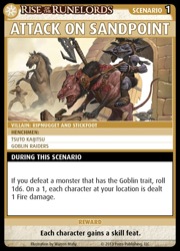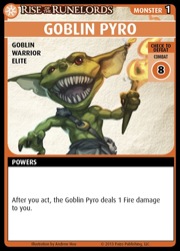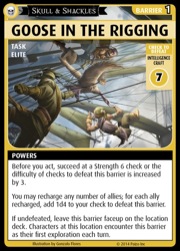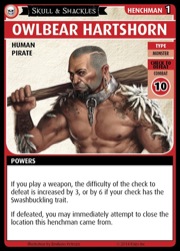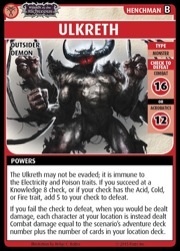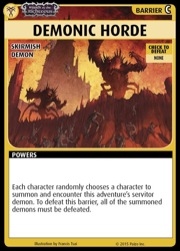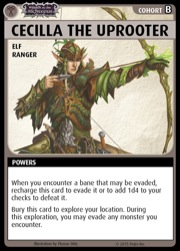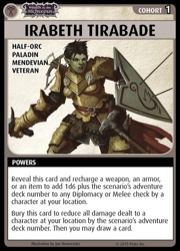Now that Wrath of the Righteous is finally in players' hands, I'd like to talk with you all about the thematic and mechanical motivations behind the different difficulty of each Adventure Path. In order to do this, I'm going to talk about each set while trying not to spoil anything, just in case some of you haven't started one of the sets.
Let's talk about what it's like to work on a game that's always changing and yet always somewhat the same. We explicitly design each PACG Adventure Path to be compatible with all of the others. This means that once you know how to play the game, you can easily jump into any set... and if you really like a particular character from a particular set, you can bring it into a different AP. Our default example of this is Lirianne, the iconic Gunslinger character in Skull & Shackles. If you decide that you'd really like to play Lirianne in Rise of the Runelords, Wrath of the Righteous, or in our upcoming release, Mummy's Mask, you can do so, and she'll work just fine. For Lirianne, we recommend that you also bring along some of the firearms from S&S, but that's up to you—she works either way.
At the same time, we also spend a lot of time, effort, and brainpower to make each Aventure Path a new and interesting experience. We use a wide variety of techniques to do this, including new characters, new mechanics, and of course, a brand-new story with each one. One important technique we use that might not be obvious to everyone is the power curve. This is a technical term we use to roughly mean, "How hard is it to get through the adventure at different points along the path?" If you've ever studied writing and film—and especially if you've ever GM'd a long campaign—you've gone through at least some of this process yourself. How strong are the characters at the start? When things get tough (as they usually do), when does it happen, and how often? Do the characters have the resources they need to protect themselves? Do they use them wisely, or do they have to scramble to get where they need to be? As the plot unfolds, are they ahead of the game, behind the eight ball, or both... and do they know it?
In our first AP, Rise of the Runelords, the adventurers start out in the small coastal city of Sandpoint. As the adventure begins, the town is attacked! A few minutes later, the typical adventuring party is moving from location to location, finding goblins with torches and kicking them in their oh-so-many teeth.
Mechanically speaking, the characters start off in a position of relative strength, but also ignorance. Unless they are risky or get unlucky, the typical character can go toe-to-toe with the typical goblin and expect to come out on top most of the time, especially if there's some help available. In the story, though, it's unclear why these torch-toting goblins would trouble the town. Figuring out that secret is the step that takes Rise of the Runelords from a one-shot "defend the town" session to an epic campaign against an ancient evil of the first order. As the story progresses, the characters grow in both knowledge and power, facing and overcoming increasingly dangerous threats on their way (both figuratively and literally) to the top.
In Rise of the Runelords, the character power progression is more or less linear over time, while the difficulty of challenges is a curve that dips and then rises. Character power starts very slightly behind the power curve in Adventure B. Then the difficulty curve dips beneath the power curve through the middle of the Adventure Path, rising over time until, very near the end, the two lines approach.
In story terms, this represents the change in difficulty as...
In Skull & Shackles, the doughty adventurers are press-ganged into service on a vessel most piratical. You start off by learning to handle life at sea, including learning to crew a vessel (and learning to hate geese) and learning how to get along with the rest of the crew, be they friendly or otherwise.
Here the characters start the campaign off-kilter—they're quickly tossed into a situation that's unlike what they're used to facing. Whether you played Rise of the Runelords or not, you probably recognized at some gut level that Valeros could fight his way free of his captors, but he would be alone on a boat in the middle of an unfamiliar sea. From both a narrative and a mechanical perspective, Skull & Shackles was a bit more difficult than Rise of the Runelords because we forced you to learn to do new things. You could still focus on being the strongest fighter, awesomest bard, or stabbiest rogue, but unless you could also handle yourself underwater, navigate a ship, and manage a crew, you were very likely to run into serious trouble. In game terms, we forced you to spread out your resources. Most characters can't afford to dedicate every card and feat to a single, focused goal.
In Skull & Shackles, the difficulty is much closer to linear—the difficulty increases mostly steadily over time—but the character power progression follows a parabolic curve. In the very beginning scenarios, character power is somewhat above the difficulty line, but it dips down below the line quickly in AD1, and then rises above the line for much of the AP. Near the end, the character power curve levels out, and it comes very close to the difficulty line by the end.
In story terms, this...
In our current Adventure Path, Wrath of the Righteous, you're in the city of Kenabres to celebrate a famous past battle against the demonic invasion into the Worldwound. Just when the festivities are about to officially start, something very bad happens. This time, though, it's not goblins with torches or pirates with whips. It's demons... lots of demons. Again, I don't want to spoil too much, but the title of the first scenario in Adventure 1 is "The Fall of Kenabres." (I can assure you that it's not the follow-up to "The Summer of Kenabres.")
This is our third set, and we have once again changed things while keeping the game the same. In this case, the characters start out "behind the curve," both in knowledge and in raw power level. The demons you face right from the get-go are tougher, more numerous, and just meaner than you've seen before. On the other hand, you have a bunch of new tools to even the score. In particular, Wrath of the Righteous adds both cohorts and mythic power. Cohorts are a new card type in this Adventure Path, representing important, named characters that will help you in your struggles against the demonic hordes.
Cohorts are bonus cards given to the party at the start of scenarios. They make you a little bit tougher, and in the right hands, they have some potent powers. Additionally, we've brought you mythic path cards, representing the unlocked potential for mythic power possessed by each of the characters in this set. Paul talked about these already, but the way they're added to the AP is important here: mythic paths are unlocked by a specific event that happens in the story. When you're playing Wrath of the Righteous, you get a chance to play a number of scenarios before you pick a mythic path card, which helps with your understanding of the card and the narrative arc of the story. On the one hand, you now have some experience with the character, and you can make a better choice of which path will be the most fun. On the other hand, it lets us level up the characters in a new way. This helps us create the feeling of being slightly overwhelmed and in trouble at the start of the AP, but it then gives you a dramatic moment where you start climbing out of the pit, bringing yourself up to the level of—and even potentially ahead of—the mass of terrible, evil banes we've assembled for you.
In Wrath of the Righteous, both the character power level and the difficulties they face are curved. Difficulty starts high, but dips quickly below the character power level before rising again. At the same time, character power level starts off relatively linear, rising as the characters recover their footing.
In story terms...
The use of the d20 in mythic paths is the final piece in the puzzle here. While it increases the top end of your checks, it doesn't help with everything. It also doesn't change the bottom end at all. As many discovered while demoing and playing WotR at the recent Origins Game Fair, d20s roll 1s just like every other die. In a set like Skull & Shackles, the d20 would be "too swingy" to use often, but in Wrath of the Righteous, it's a great fit. You each have within you the potential to do truly amazing things, but so do your opponents. The results are far from certain... which is kinda what we were going for.
Since we released Wrath of the Righteous, we've heard from some people that the start of the Adventure Path— especially the scenarios in Adventure B—are tougher than they expected. Hopefully, you now have a better idea what we were trying to accomplish with this set and how did it. On the other hand, if you are finding that the start of WotR is so hard that you're not having enough fun, there are a number of options available.
First and foremost, remember that the B Adventure is optional for the Adventure Path. It's recommended, but it's not required. If you would prefer to start with Adventure Deck 1: The Worldwound Incursion, that's perfectly fine. Also, if you'd like to play a little bit of AD1 and then go back and complete the B Adventure, you should feel free to do so. In a more extreme variation, you might even choose to finish all of AD1 before completing the B scenarios, but be aware that you will be significantly stronger at that point. In the end, any way that you find to have fun is a great way to play.
Chad Brown
Adventure Card Game Lead Developer





